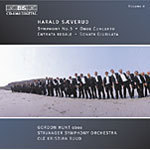
Orchestral Vol. 6 (Includes Symphony No.5, 'Quasi una fantasia')
 $37.00
Out of Stock
$37.00
Out of Stock6+ weeks add to cart
SAEVERUD
Orchestral Vol. 6 (Includes Symphony No.5, 'Quasi una fantasia')
Gordon Hunt (oboe) / Stavanger Symphony Orchestra conducted by Ole Kristian Ruud
[ BIS / CD ]
Release Date: Thursday 30 October 2003
This item is currently out of stock. It may take 6 or more weeks to obtain from when you place your order as this is a specialist product.
"Superb recordings in the normal BIS manner, with similarly excellent performances from the Stavanger Symphony Orchestra. More please!"
(MusicWeb Feb 2004)
Harald Sæeverud (1897-1922) is a gigantic figure in his native country of Norway. (When he died he was given a televised state funeral!) Yet such has been the blinding radiance of Edvard Grieg that Sæeverud's music made comparatively little impact outside his native country until BIS started its pioneering project of recording his orchestral music with the Stavanger Symphony Orchestra. The present disc represents the seventh volume in the series and contains the fifth symphony as well as his oboe concerto and some orchestral pieces for festive occasions.
Harald Sæverud was born and lived almost his entire life in Bergen, the ancient Hansa city which, for centuries, had been Norway's window on the world. Sæverud - like Grieg, another native son of Bergen - were to gain musical impulses from Germany - Grieg while he was in Leipzig and Sæverud while in Berlin. Both of them also nourished a close interest in folk music. Grieg made direct use of folk music which he reworked and arranged. Sæverud, on the other hand, used folklore as a source of inspiration and produced his 'own' folk music.
Sæverud's Fifth Symphony is the first of his so-called 'war symphonies'. Sæverud did not deny that these symphonies were directly influenced by the German occupation of Norway but it was only after the war that he could reveal the true name of the fifth symphony - 'Symphony of resistance'. The symphony made a great impression on the audience at the first wartime performance. A reviewer summed up the importance attached to the symphony 'It has a national appeal unequalled in Norwegian music. It will be of historical consequence to the extent that our young people are able to experience art and feel national values. It will inspire faith, perseverance, gentle deeds and bold actions.'
The Oboe Concerto was written for a famous oboist of the time, Rolf Lännerholm, who premièred it with the Gothenburg Symphony Orchestra at a music festival. It is dedicated to the composer's American wife, Marie. His first meeting with her inspired his "loveliest melody" which is heard in the slow movement. Here the concerto is again performed by one of the leading oboists of the day, Gordon Hunt.
Tracks:
Symphony No.5, 'Quasi una fantasia', Op.16 (1941)
Oboe Concerto, Op.15 (1939)
Entrata regale, Op.41 (1960)
Sonata Giubilata, Op.47 (1969)

